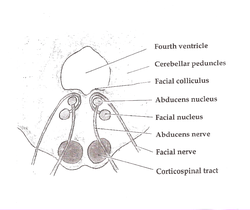Paramedian pontine reticular formation
| Paramedian pontine reticular formation | |
|---|---|

Axial section of the pons at the level of the facial colliculus (PPRF not labeled, but region is visible, near abducens nucleus)
|
|
| Details | |
| Identifiers | |
| Latin | Formatio reticularis pontis paramediana |
| NeuroNames | ancil-479 |
|
Anatomical terms of neuroanatomy
[]
|
|
The paramedian pontine reticular formation, also known as PPRF or paraabducens nucleus, is part of the pontine reticular formation, a brain region without clearly defined borders in the center of the pons. It is involved in the coordination of eye movements, particularly horizontal gaze and saccades.
The PPRF is located anterior and lateral to the medial longitudinal fasciculus (MLF). It receives input from the superior colliculus via the predorsal bundle and from the frontal eye fields via frontopontine fibres. The rostral PPRF probably coordinates vertical saccades; the caudal PPRF may be the generator of horizontal saccades. In particular, activity of the excitatory burst neurons (EBNs) in the PPRF generates the "pulse" movement that initiates a saccade. In the case of horizontal saccades the "pulse" information is conveyed via axonal fibres to the abducens nucleus, initiating lateral eye movements. The angular velocity of the eye during horizontal saccade ranges from 100 to 700 degrees per second. Larger saccades have faster pulses; the PPRF is involved in this determination.
Unilateral lesions of the PPRF produce characteristic findings:
Bilateral lesions produce horizontal gaze palsy and slowing of vertical saccades
...
Wikipedia
